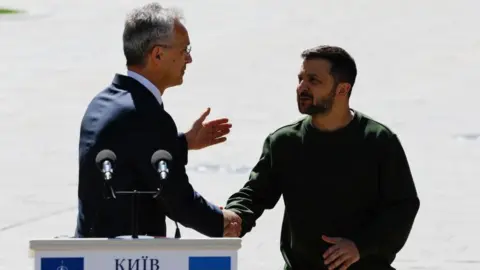Introduction: A Battlefield Cry for Protection
Ukrainian President Volodymyr Zelensky has once again urged NATO to expedite Ukraine’s membership process. In his recent address during the NATO Summit 2025 in Brussels, he stated bluntly, “We cannot win this war with promises—we need guarantees.” As the Russia-Ukraine conflict enters its fourth year, NATO’s hesitation is influencing more than diplomatic headlines—it’s shaping battlefield realities.
The delay in Ukraine’s NATO membership has strategic, political, and humanitarian consequences. While Western nations continue to send arms and funds, formal inclusion in the alliance—and its Article 5 security umbrella—remains elusive.
Why NATO Is Still Holding Back in 2025
NATO member states, particularly Germany, France, and the U.S., cite fears of direct confrontation with Russia as their reason for delaying Ukraine’s accession. There’s growing concern that extending Article 5 protections to Ukraine could provoke broader escalation with a nuclear-armed Moscow.
According to Politico Europe, the alliance is instead offering “incremental security assurances,” such as joint defense exercises and long-term military aid packages. Yet, without formal NATO membership, these measures stop short of full deterrence.
Impact on Ukraine’s War Strategy
The membership delay is reshaping Ukraine’s military calculus. Here’s how:
- Increased Reliance on U.S. and UK Support: Kyiv has prioritized bilateral pacts, including a renewed 10-year defense treaty with Washington signed in April 2025.
- Adapted Defense Tactics: Ukraine’s military is shifting to more asymmetric tactics to counterbalance a superior Russian air force and long-range missile capabilities.
- Delayed Counteroffensives: Without assured NATO backup, Ukraine is holding off on major counteroffensives that could trigger wider Russian escalation.
Zelensky’s NATO Speech: A Strategic Gamble
During the NATO summit, Zelensky warned that indecision empowers Putin. “Every delay is a green light for Moscow,” he declared. His speech struck a chord with Eastern European members like Poland and the Baltic states, which continue to lobby for Ukraine’s fast-tracked inclusion.
However, Western powers remain divided. The Biden administration voiced support for Ukraine’s future in NATO but emphasized the need for “timing and unity among all allies.”
What Russia Gains From NATO’s Delay
The Kremlin continues to exploit the ambiguity. Russian state media portrays the delay as proof of NATO’s weakness and reluctance. On the battlefield, Moscow escalated drone strikes on Ukrainian logistics hubs in Kharkiv and Mykolaiv, calculating a muted NATO response.
Experts from CSIS warn that unless NATO clarifies its intentions, Russia will continue to “test the red lines of the West” with increasing boldness.
Conclusion: Strategic Patience or Risky Hesitation?
The delay in Ukraine’s NATO membership reflects a broader struggle between Western caution and Eastern urgency. For Ukraine, each month outside the alliance translates into more vulnerability and fewer strategic options. For NATO, the decision remains a delicate balance of deterrence and diplomacy.
Zelensky’s plea is not just for membership—it’s for survival. Whether NATO’s slow march forward will be fast enough remains a question with consequences far beyond Eastern Europe.


